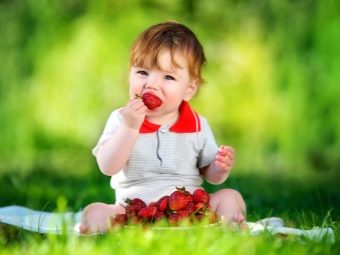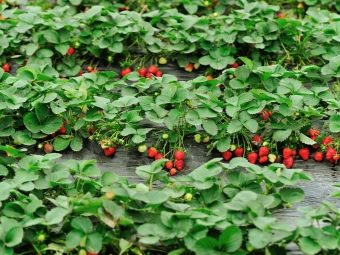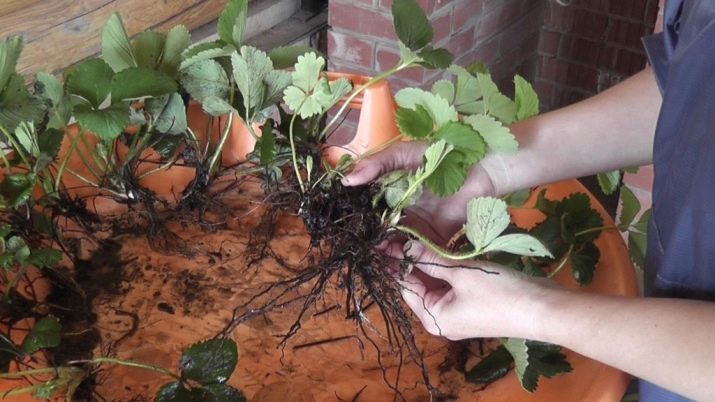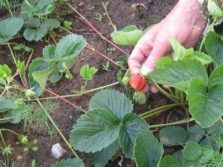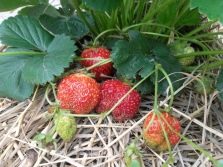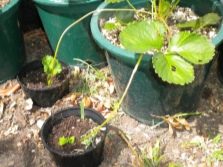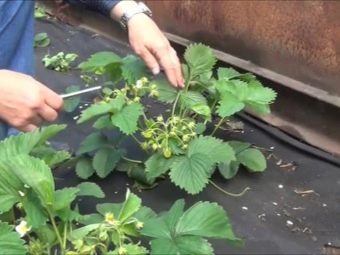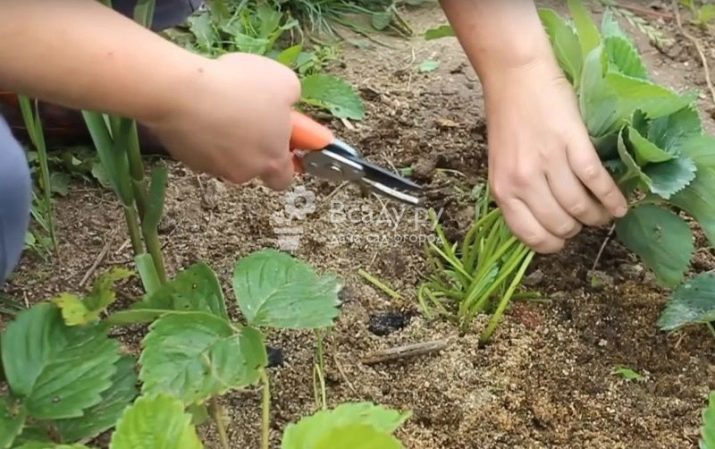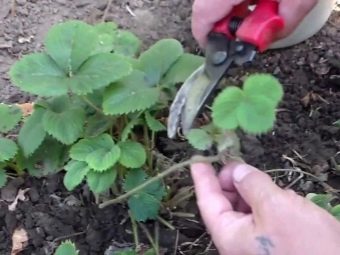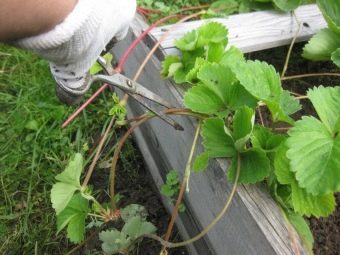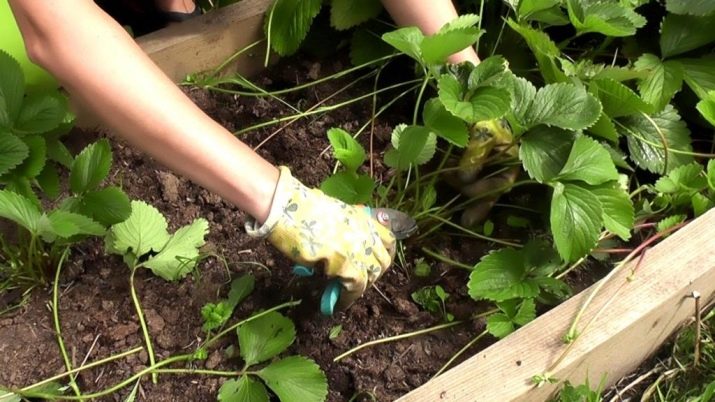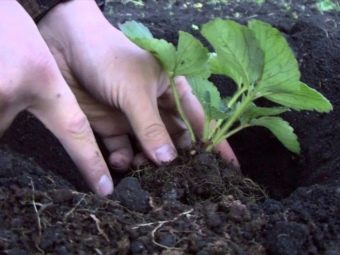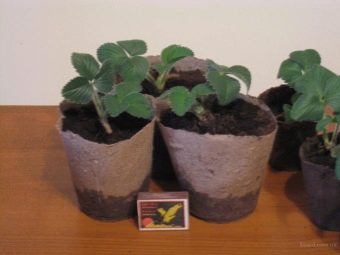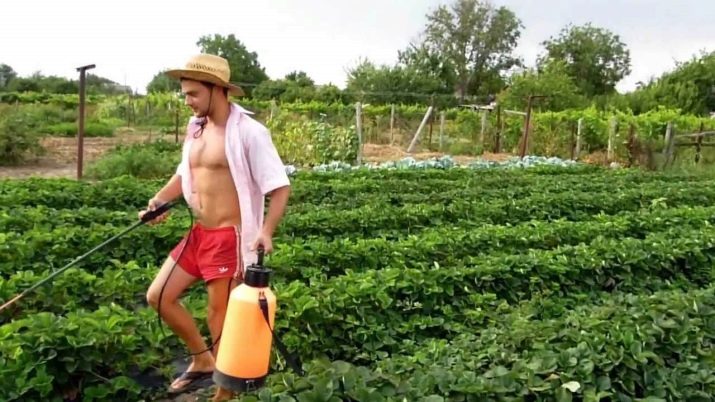When do you need to trim a mustache in a strawberry?

Strawberries or the so-called garden strawberries, due to the aroma, juiciness and sweet taste of berries, is one of the favorite delicacies of both adults and children. Cultivated in almost every region, it can produce a good and fairly early harvest with proper care. Many people mistakenly believe that the yield depends largely on the variety and weather conditions. But this is not the case. Even with the most adverse weather conditions, with a correct and competent approach to caring for the crop, you can achieve quite a good harvest.
In addition to abundant watering, timely feeding, the quality and quantity of berries are also affected by the trimming of the whiskers in time, through which the culture multiplies. It is referring to the need to breed strawberries, some gardeners, as a rule, beginners ignore the above procedure.
What is pruning for?
Strawberries are propagated in two ways: by dividing the bush, which injures the root system, and with the help of a mustache, which does not adversely affect the plant itself. But sparing culture propagation through the whiskers should not be a reason for refusing to prune them. To remove the whiskers from strawberries is not something that is possible, but necessary, without fear of remaining without stock of seedlings, since there is always the opportunity to stock up on new planting material.
This procedure must be carried out continuously and on time. Whiskers that form around the second half of July, which practically coincides with flowering (depending on the variety and region), take a lot of energy from an already weakened bush. The result is that by dividing the energy between the mustache and the ovary of flowers, the plant produces small and tasteless berries, which, by the way, will be few in the garden. And, conversely, by removing the whisker, we direct all the energy to the flowers tied in large quantities, instead of which large and juicy berries form over time.
Thus, pruning has a beneficial effect on the following points:
- affects the taste and size of the berries;
- promotes the ovary of more flowers, which leads to high yields.
How then to propagate strawberries? This is another question that we will address later.
Timing
Having decided to trim a mustache, the gardeners often have a question as to when it is better to produce it: during fruiting, flowering, or it will be right to postpone the procedure until the autumn, and even until spring. And each gardener has his own opinion on this.
The fact is that to achieve large-scale harvest pruning is performed twice a year:
- in spring, when growing young shoots are removed. This allows you to save power well fructifying more mature bushes;
- the next pruning is done when the bush blooms. After all, the yield directly depends on the amount of energy directed to the floral ovary. In other words, the more flowers, the more berries.
And one more fact requiring the attention of a gardener: after fruiting, a mustache reappears on the strawberry bushes, which should not be left until spring for two reasons:
- the soil gradually begins to cool by the autumn, therefore, there can be no talk that the newly grown mustache will be accepted and by spring we will receive seedlings;
- rainy autumn days can be the reason why post-harvest mustache will start to rot, which is fraught with infection of the whole bush.
The third, autumn, pruning to yield has nothing to do. This is the so-called seasonal preventive measure to strengthen the culture for the winter. But its implementation is just as necessary as cropping in the previous periods before it (see above).
Process subtleties
The procedure for cutting a mustache is quite simple, but in spite of this you shouldn’t pick your hands off your neck, since it is quite strong and excessive twitching can damage an already vulnerable strawberry. And to restore a broken root system is not as difficult as recognizing.Signs of damage to the root system can only be distinguished from signs of damage to a culture by specialists, probably, to specialists. You can remove them as a last resort with ordinary scissors or a knife, and the shears are ideal for removal.
The second no less important point is related to the length of the usa removed. Clean the mustache fully possible only after the end of fruiting, that is, in the fall. In the spring or during the flowering period, they are only pruned to ten centimeters. But in no case, we note once again, it is impossible to tear them off either in spring, in summer, or in autumn.
It is not recommended to perform the procedure both on a hot and rainy day, since any manipulations related to strawberries subject her bushes to stress. And adverse weather conditions will increase the negative impact, which will make the culture during this period particularly vulnerable and less resistant to external stimuli (sun, excessive watering, insects). The most favorable time for this is considered to be morning or evening hours (if there are no cool days).
How to get a mustache for breeding?
After the removal of the whiskers, it is often the case that gardeners, as a rule, newbies, have a question: what to do with them. And in principle, there is nothing to be done, since initially (before removal) it is necessary to choose and leave the strongest for the planting material.
Thus, before the whisker removal procedure, it is recommended to determine how much you need additional seedlings. If the need is substantial, then we can limit ourselves not only to preserving the strongest mustache for the further development of the bush, but it is also quite acceptable to plant a regular trimmed mustache in a cup for its further development and planting.
So, if you especially do not need seedlings, but you want to be safe, then just in case during the second pruning, you can take the strongest, having several leaf sockets, mustaches and transplant them to another place, lightly dusted in the hole with soil. In addition, they are selected from the bushes, distinguished themselves by particularly strong flowering. The mustache that cut off in the center of the bush, and those on the sides are unconditionally removed, takes root most quickly on the new spot.
When there is no free space on the plot, your growth will not be lost in the cup on the windowsill, but for it it is better to take peat soil. And after the harvest is completed (July – August), it can be replaced by bushes that give bad yields. For example, young seedlings that were planted in August on the windowsill, which had grown strong on a windowsill, will take root by September, which will not require special measures by winter.
As for the planting material from spring pruning, here it is desirable to simply remove the weakest and most unsightly-looking mustache. Since in the spring the culture still did not “spread out” properly, it is quite difficult to distinguish a mustache from a strong bush or a weak one.
Aftercare
We have already noted that strawberries are a very vulnerable plant, requiring special care at times unfavorable to it and in the period of any impact. And it would seem, at first glance, a harmless trimming of a mustache is no exception, since it is, in fact, an operation. The first thing that is recommended to do is to process the place of the cut (we are talking only about spring and summer pruning). For this purpose it is recommended to prepare a water concentrate on the basis of brilliant green at the rate of 1 drop of brilliant green per 1 liter of water. If possible, the resulting solution is treated with the cut, using cotton wool. Locally infused greens will disinfect the wound, which will contribute to rapid recovery.
If you have a large strawberry plantation or, for some other reason, it is not possible to process each section, then irrigation of the bed with the above concentrate will be appropriate.Only for this you need a stronger solution (for one liter of water you can take 2 drops of green), which, maybe not hitting the wound, will not process it, but at least it will be a preventive procedure against the appearance of certain ailments - for example, rot - yes pests . In addition, the drug is well established as a natural fertilizer (it contains the necessary amount of copper for the plant), which strengthens the immune system of the plant.
If you turn to the people's councils, the ash has proved itself to be a good idea, sprinkling the soil of which prevents the appearance of many insects, for example, wasps and ants. Well, since the listed prophylactic and reparative agents are not suitable for you, then the best option would be the treatment of strawberries with Fitosporin, which is sold in specialized stores.
When resorting to the help of agrochemicals, remember that many of them are forbidden to process strawberries during the flowering period and beyond, because they cause nitrates to accumulate on the plant.
Today, of course, there are strawberry varieties that do not give a mustache, but this fact does not make the variety privileged. Specially experienced gardeners also manage to grow strawberries without cutting their mustache at all. But such cultivation requires some knowledge and considerable experience. And besides, this method involves updating the culture every 3-4 years, depending on the soil and climatic conditions of the region.
See how the strawberry mustache should be trimmed in the video below.

